Blog
Virtuals Protocol (VIRTUAL) บนเครือข่าย Solana ที่ทำให้ผู้ใช้งานสามารถเป็นเจ้าของ AI-agent
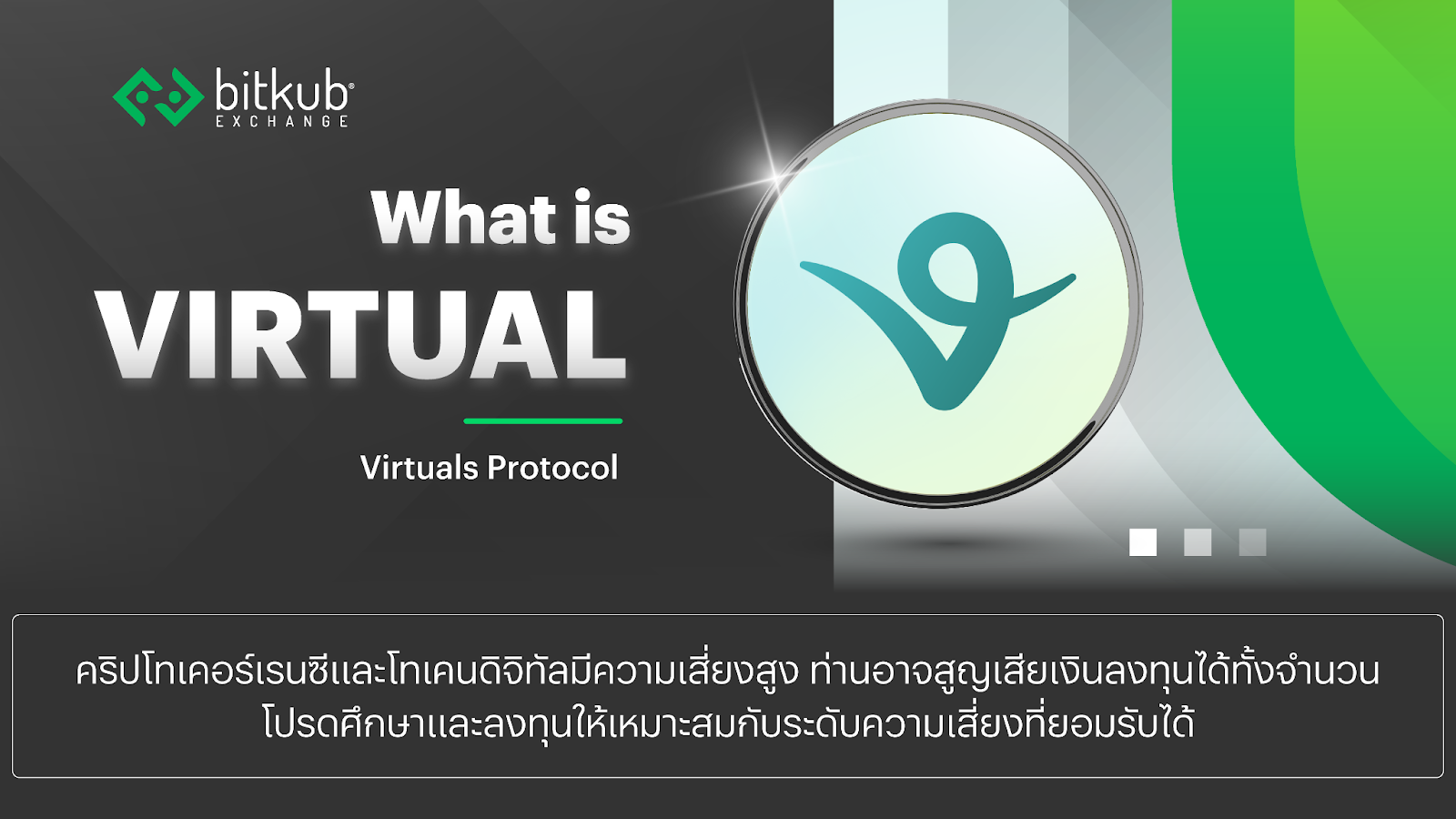
ในโลก Web 3 มีการเปลี่ยนแปลงอยู่ตลอดเวลา โดยปัจจุบันเกิดจุดเชื่อมโยงกันระหว่าง ปัญญาประดิษฐ์และเทคโนโลยีบล็อกเชน โดย Virtuals Protocol (VIRTUAL) เข้ามาเป็นส่วนหนึ่งของการพัฒนาแพลตฟอร์มล้ำยุคที่กำลังนิยามการทำงานร่วมกันระหว่าง AI ผ่านพลังของการกระจายอำนาจ สำหรับผู้ที่อยากรู้กลไกเบื้องหลังแนวคิดล้ำยุคนี้ บทความนี้จะพาทุกคนไปทำความรู้จัก
Virtuals Protocol คืออะไร?
Virtuals Protocol เป็นเครือข่ายแบบกระจายอำนาจที่ออกแบบมาเพื่อการสร้าง การฝึกอบรม และการใช้งาน “Virtuals” หรือ AI-agent ที่มีความซับซ้อน เพื่อสร้างบริการหรือผลิตภัณฑ์เพื่อใช้ในเชิงพาณิชย์ ซึ่งแตกต่างจากโมเดล AI แบบดั้งเดิม โดย Virtuals ออกแบบมาให้โต้ตอบได้ เป็นอิสระ และที่สำคัญที่สุดคือสามารถเป็นเจ้าของได้ โดย AI-agent จะถูกแปลงเป็นโทเคน ทำให้เกิดการสร้างทุน การมีส่วนร่วมได้อย่างกว้างขวาง เป็นการสร้างแรงจูงใจที่สอดคล้องกันระหว่างผู้สร้าง นักลงทุน และตัวแทน
แนวทางการพัฒนาหลักของเทคโนโลยีคือการบูรณาการ AI เข้ากับบล็อกเชน ด้วยมาตรฐาน ERC-6551
ซึ่งช่วยให้ตัวแทน AI แต่ละตัวมีกระเป๋าเงินบนเครือข่ายบล็อกเชนของตัวเอง ทำให้สามารถเป็นเจ้าของสินทรัพย์ ทั้งยังโต้ตอบกับ แอปพลิเคชันแบบกระจายอำนาจ (dApps) และมีความโปร่งใส นอกจากนี้โปรโตคอลนี้ยังมอบ กรอบงานที่ครอบคลุมสำหรับนักพัฒนาเพื่อสร้าง AI agents, ส่งเสริมระบบนิเวศ และความก้าวหน้าทางเทคโนโลยี
คุณสมบัติหลักและฟังก์ชันการทำงาน
– การเป็นเจ้าของ AI อย่างแท้จริง: เป็นการออกแบบเพื่ออนุญาตให้มีการสร้างความเป็นเจ้าของบางส่วน ผ่านการสร้างโทเคนให้กับ AI agent แต่ละตัว ซึ่งหมายความว่าชุมชนสามารถเป็นเจ้าของ บริหาร และได้รับประโยชน์จากกรรมของ Virtual ซึ่งจะทำให้การพัฒนา AI เป็นไปอย่างอิสระและหลุดจากกรอบการควบคุมแบบรวมศูนย์ของบริษัทเทคโนโลยีขนาดใหญ่
– การแบ่งปันรายได้: AI agents บน Virtuals Protocol สามารถออกแบบมาเพื่อสร้างรายได้ ไม่ว่าจะเป็นผ่านธุรกรรมในเกม การให้บริการวิเคราะห์ หรือการสร้างเนื้อหาดิจิทัล รายได้ที่สร้างขึ้นจะถูกแจกจ่ายไปยังผู้ถือโทเคน ซึ่งจะสร้างแรงจูงใจทางเศรษฐกิจโดยตรงสำหรับการมีส่วนร่วมและการพัฒนาชุมชน
– การกำกับดูแลแบบกระจายอำนาจ: โปรโตคอลทำงานบนโมเดลการกำกับดูแลแบบกระจายอำนาจ ผู้ถือโทเคนVIRTUAL และโทเคนเฉพาะของ AI agents แต่ละตัวมีสิทธิ์ในการตัดสินใจเกี่ยวกับการพัฒนา การอัปเกรด และพารามิเตอร์การทำงาน
– การทำงานร่วมกัน: โปรโตคอลที่สร้างขึ้นบนมาตรฐานที่รองรับการทำงานร่วมกันได้ระหว่างเเมตาเวิร์ส เกม และระบบนิเวศบล็อกเชนที่แตกต่างกัน ช่วยให้ AI agents สามารถข้ามผ่านขอบเขตของแพลตฟอร์มได้
โทเคน VIRTUAL คืออะไร?
โทเคน VIRTUAL เป็น native utility และ governance token ของระบบนิเวศ Virtuals Protocol ซึ่งเป็นหัวใจสำคัญของโปรโตคอล โดยทำหน้าที่สำคัญหลายประการ:
– สื่อกลางในการแลกเปลี่ยน โดยใช้เป็นสกุลเงินหลัก สำหรับการทำธุรกรรมภายในโปรโตคอล รวมถึงการสร้างและการซื้อขายเอเจนต์ AI
– การทำ Staking และ การกำกับดูแล โดยผู้ถือโทเคน สามารถ Staking VIRTUAL ของตนเพื่อเข้าร่วมในการควบคุมโปรโตคอล ซึ่งส่งผลต่อทิศทางในอนาคต ทั้งยังได้รับรางวัลซึ่งจะช่วยสร้างแรงจูงใจในการมีส่วนร่วมมากขึ้น
– สำหรับการพัฒนาระบบนิเวศ โดยโทเคนถูกใช้เพื่อขับเคลื่อนคุณสมบัติต่างๆ ของโปรโตคอล ตั้งแต่การฝึกโมเดล AI ไปจนถึงการอำนวยความสะดวกในการทำธุรกรรมภายในเครือข่าย
การกระจายโทเคนของ VIRTUAL
โทเคน VIRTUAL มีอุปทานทั้งหมด 1,000 ล้านโทเคน โดยมีการจัดสรรที่วางแผนอย่างรอบคอบเพื่อส่งเสริมระบบนิเวศที่ยั่งยืนและเติบโต การแจกจ่ายมีดังนี้:
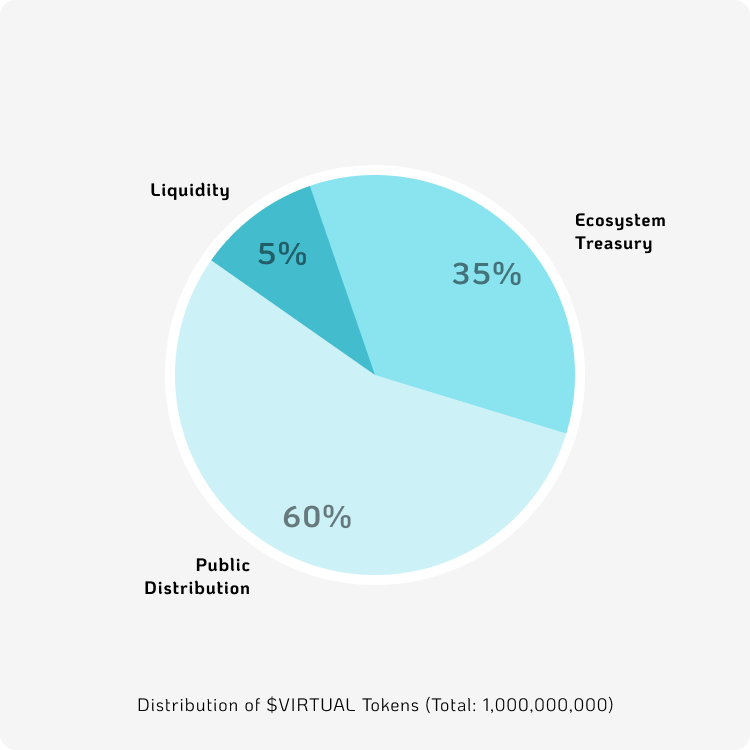
– การกระจายโทเคนสำหรับสาธารณะชน 60% (600,000,000 tokens) ณ วันที่ 4 มิถุนายน 2025 ตอนนี้โทเคนเหล่านี้หมุนเวียนอยู่ในตลาด
– Liquidity Pool 5% (50,000,000 tokens) ตั้งไว้สำหรับแหล่งสภาพคล่อง
– ระบบนิเวศ (Ecosystem) 35% (350,000,000 tokens) ไว้สำหรับระบบนิเวศเพื่อสร้างแรงจูงใจให้กับระบบนิเวศ และสร้างความเติบโตให้กับระบบนิเวศของ VIRTUAL protocol
การกระจายโทเคน VIRTUAL ได้รับการออกแบบมาให้ลดจำนวนลงตามเวลาที่กำหนด ส่วนหนึ่งของรายได้ที่สร้างโดยโปรโตคอลจะถูกใช้เพื่อซื้อและเผาโทเคน ทำให้อุปทานทั้งหมดลดลงและอาจเพิ่มมูลค่าของโทเคน ซึ่งระบบเทคโนโลยี ความเป็นเจ้าของชุมชน และแรงจูงใจทางเศรษฐกิจที่ซับซ้อนนี้ทำให้ Virtuals Protocol กลายเป็นผู้มีบทบาทสำคัญในอนาคตของ AI แบบกระจายอำนาจ
ข้อมูลน่าสนใจด้านราคาของ VIRTUAL
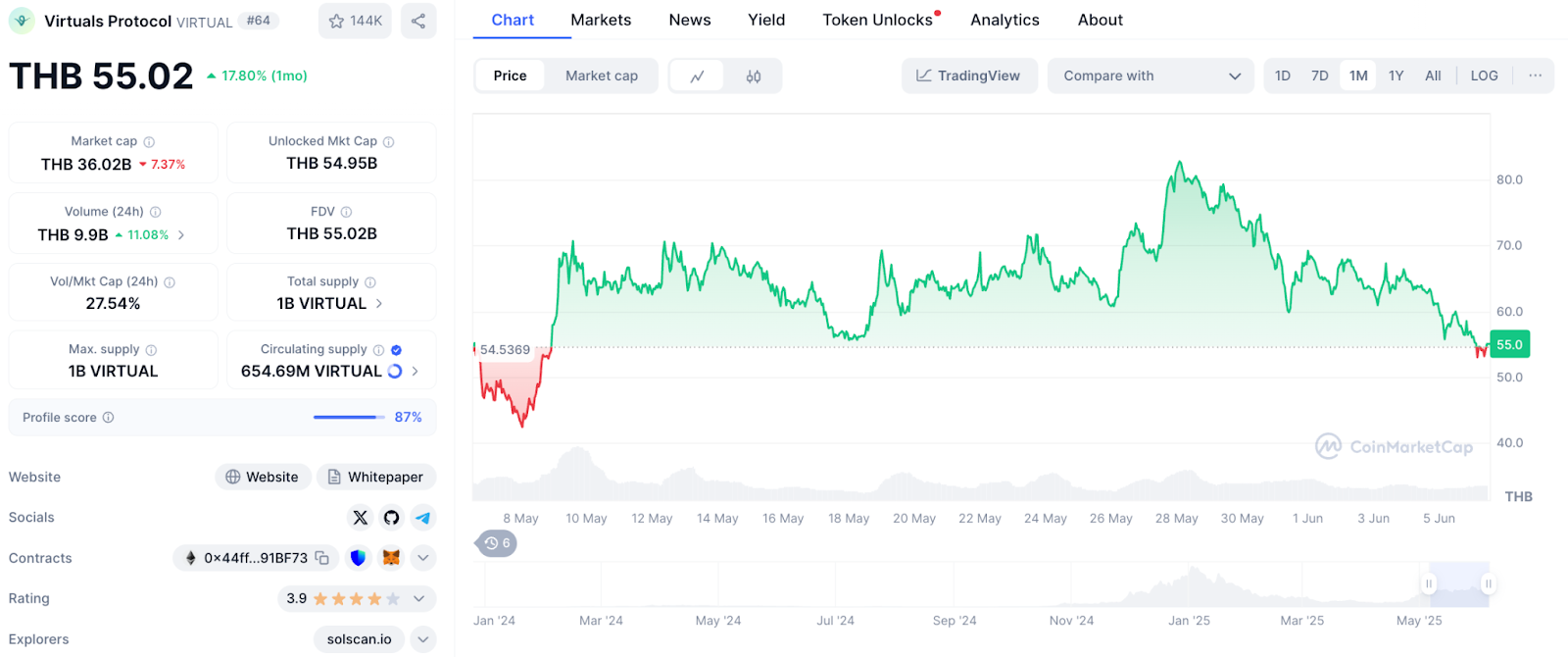
ข้อมูลจากเว็บไซต์ CoinMarketCap เมื่อวันที่ 6 มิถุนายน 2025 โทเคน VIRTUAL มีมูลค่าตามราคาตลาด (Market cap) ที่ 1,111,149,180.45 ดอลลาร์สหรัฐฯ หรือประมาณ 36,252,023,717.29 บาท
ณ เวลาที่เขียนบทความนี้โทเคน VIRTUAL ซื้อขายกันอยู่ที่ราคาประมาณ 1.69 ดอลลาร์สหรัฐฯ หรือประมาณ 55.02 บาทต่อ 1 VIRTUAL โดย VIRTUAL เคยทำราคาสูงสุด (All-time high) ที่ 5.07 ดอลลาร์สหรัฐฯ หรือประมาณ 165.57 เมื่อวันที่ 2 มกราคม 2025
ที่มา: Virtuals Protocol Whitepaper
— — — — — — — — — — — — — — — — —

หากคุณยังเป็นมือใหม่ ค้นหาข้อมูลเพิ่มเติมได้ในบทความ “แหล่งความรู้ มือใหม่หัดเทรดคริปโต เริ่มต้นที่นี่” แล้วมาเริ่มต้นเทรดได้วันนี้ที่ Bitkub Exchange → คลิกสมัครเลย
— — — — — — — — — — — — — — — — —
คำเตือน:
- คริปโทเคอร์เรนซีและโทเคนดิจิทัลมีความเสี่ยงสูง ท่านอาจสูญเสียเงินลงทุนได้ทั้งจํานวน โปรดศึกษาและลงทุนให้เหมาะสมกับระดับความเสี่ยงที่ยอมรับได้
- ผลตอบแทนของสินทรัพย์ดิจิทัลในอดีตหรือผลการดําเนินงานในอดีต มิได้เป็นสิ่งยืนยันถึงผลตอบแทน ของสินทรัพย์ดิจิทัลหรือผลการดําเนินงานในอนาคต
— — — — — — — — — — — — — — — — —
Virtuals Protocol (VIRTUAL) on Solana, Enabling Users to Own AI Agents
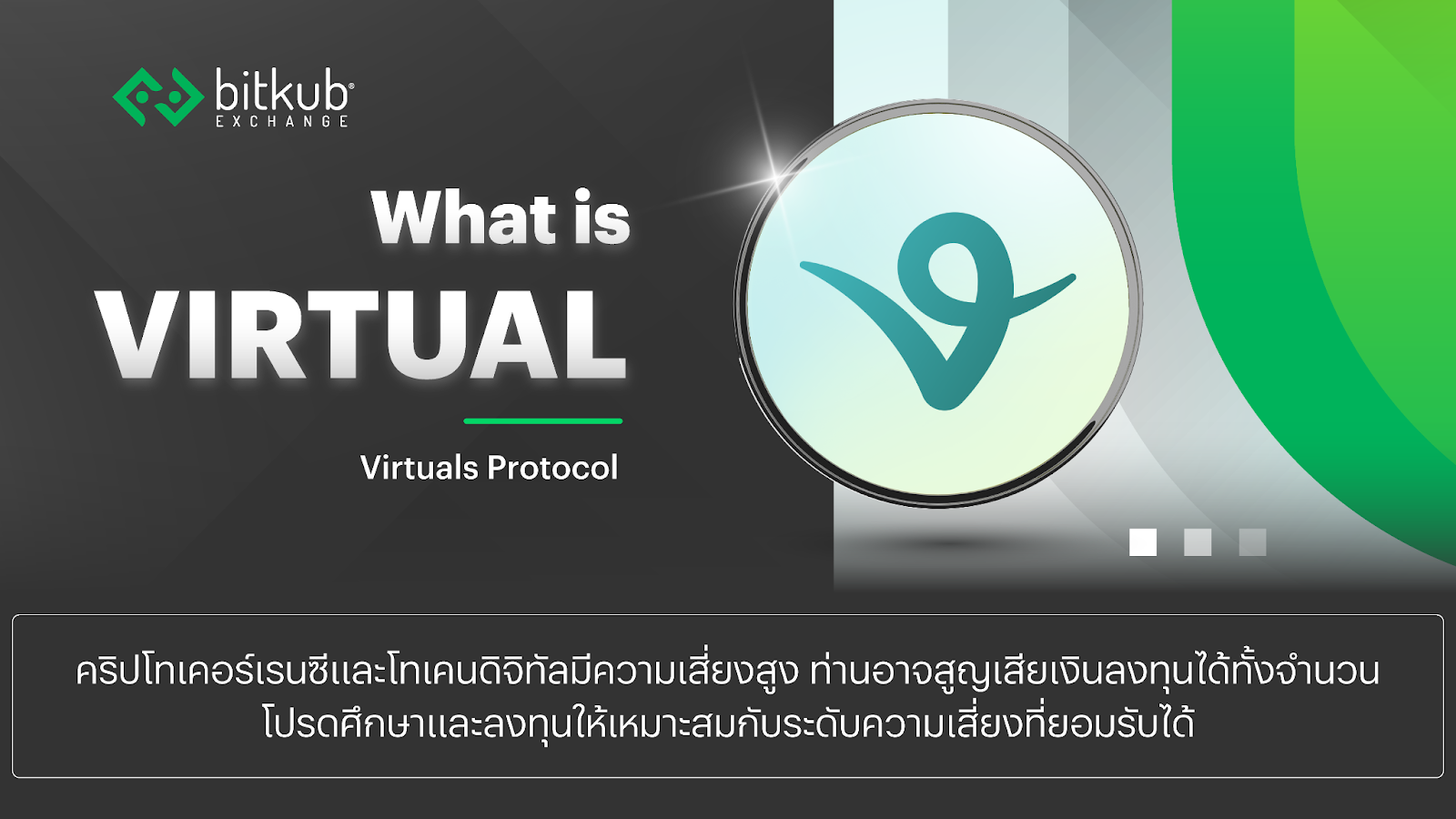
In the ever-evolving landscape of digital innovation, a new frontier is emerging at the intersection of artificial intelligence and blockchain technology. At the vanguard of this movement is the Virtuals Protocol (VIRTUAL), a groundbreaking platform that is redefining our interaction with AI through the power of decentralization and digital ownership. For those curious to understand the mechanics behind this futuristic concept, here’s an in-depth look.
What is Virtuals Protocol and Its Technology?
Virtuals Protocol is a decentralized network designed for the creation, training, and deployment of “Virtuals” — sophisticated, AI-powered agents. Unlike traditional, siloed AI models, these Virtuals are designed to be interactive, autonomous, and, most importantly, ownable. The core of its technology lies in integrating AI with blockchain, specifically utilizing the ERC-6551 standard. This allows each AI agent to have its own blockchain wallet, enabling it to own assets, interact with decentralized applications (dApps), and maintain a transparent, on-chain history of its activities. This creates a new paradigm where AI is not just a tool, but a participant in the digital economy.
The protocol provides a comprehensive framework for developers to build and launch these AI agents, fostering an ecosystem where creativity and technological advancement can flourish. These Virtuals can be designed for a multitude of purposes, from in-game non-player characters (NPCs) that learn and adapt, to personalized digital assistants and companions.
Highlight Features
The Virtuals Protocol is distinguished by several key features that set it apart:
— True AI Ownership: By tokenizing each AI agent, the protocol allows for fractional ownership. This means a community can collectively own, govern, and benefit from a Virtual’s activities. This democratizes AI development and moves away from the centralized control of big tech companies.
— Revenue Sharing: AI agents on the Virtuals Protocol can be designed to generate revenue. Whether through in-game transactions, providing analytical services, or creating digital content, the income generated is distributed among the token holders of that specific Virtual. This creates a direct economic incentive for community participation and development.
— Decentralized Governance: The protocol operates on a decentralized governance model. Holders of the VIRTUAL token and the specific tokens of individual AI agents have a say in their development, upgrades, and operational parameters.
— Interoperability: Built on an open standard, the protocol is designed to be interoperable across different metaverses, games, and blockchain ecosystems, allowing the AI agents to transcend the boundaries of a single platform.
The VIRTUAL Token
The native utility and governance token of the ecosystem is the VIRTUAL token. It is the lifeblood of the protocol, serving several critical functions:
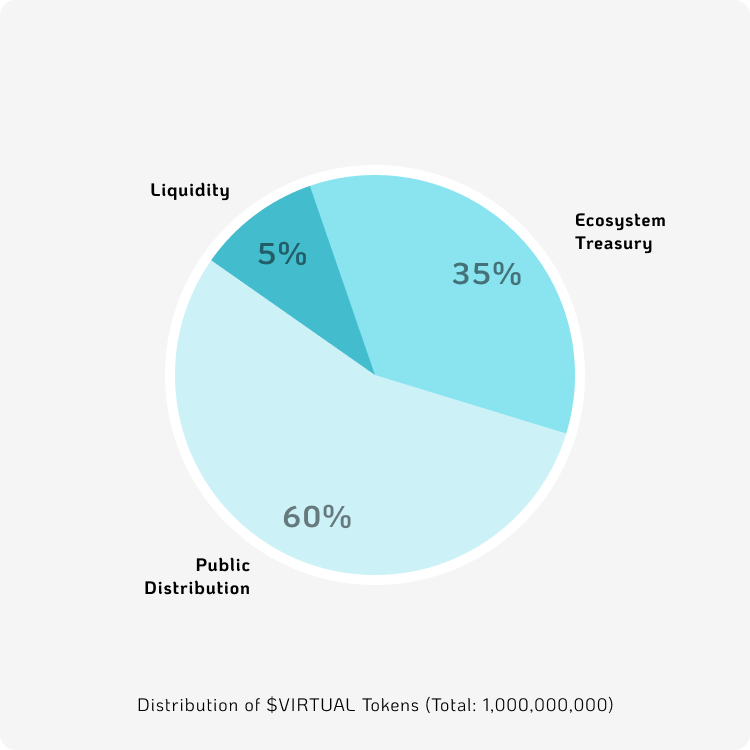
— Medium of Exchange: VIRTUAL is the primary currency used for transactions within the protocol, including the creation and trading of AI agents.
— Staking and Governance: Token holders can stake their VIRTUAL to participate in the governance of the protocol, influencing its future direction. Staking also provides rewards, further incentivizing participation.
— Ecosystem Fuel: The token is used to power the various features of the protocol, from training AI models to facilitating transactions within the network.
Token Allocation and Tokenomics
The VIRTUAL token has a total supply of 1 billion tokens, with a carefully planned allocation designed to foster a sustainable and growing ecosystem. The distribution is as follows:
— Public Distribution: 60% (600,000,000 tokens). As of June 4, 2025, these tokens are circulating in the market.
— Liquidity Pool: 5% (50,000,000 tokens) allocated for the liquidity pool.
— Ecosystem: 35% (350,000,000 tokens) reserved for the ecosystem to provide incentives and to foster the growth of the VIRTUAL protocol’s ecosystem.
The tokenomics of VIRTUAL are designed to be deflationary over time. A portion of the revenue generated by the protocol is used to buy back and burn VIRTUAL tokens, reducing the total supply and potentially increasing their value. This intricate system of technology, community ownership, and economic incentives positions the Virtuals Protocol as a significant player in the future of decentralized AI.
Interesting Price Information for VIRTUAL
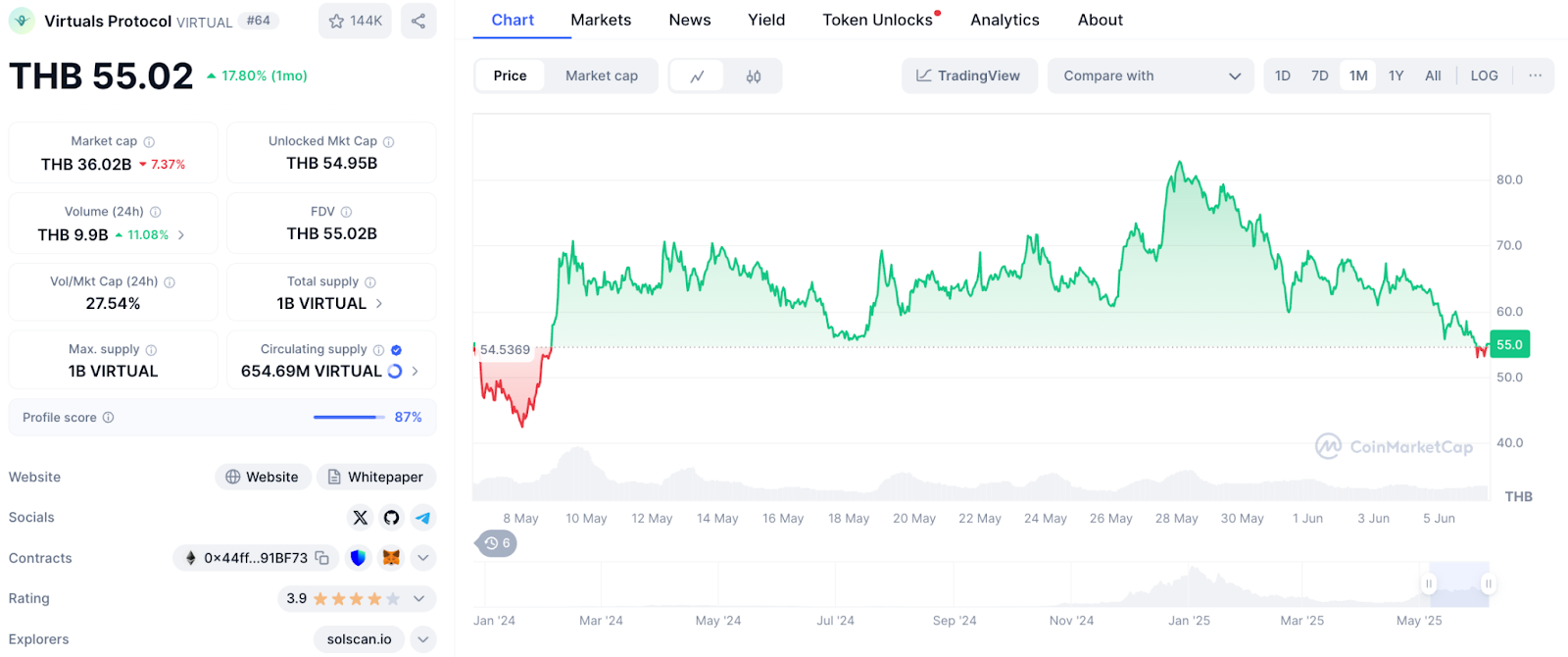
According to data from CoinMarketCap on June 6, 2025, the VIRTUAL token has a market cap of $1,111,149,180.45 USD, or approximately 36,252,023,717.29 THB.
As of this writing, the VIRTUAL token is trading at approximately $1.69 USD, or about 55.02 THB per VIRTUAL. VIRTUAL reached its all-time high of $5.07 USD (approximately 165.57 THB) on January 2, 2025.
Reference: Virtuals Protocol Whitepaper
— — — — — — — — — — — — — — — — —

New to crypto? Learn the ropes with our beginner’s guide, ‘Crypto Knowledge for beginners’. When you’re ready, take the next step and start trading today at Bitkub Exchange. Click here to apply!
— — — — — — — — — — — — — — — — —
Disclaimer:
— Cryptocurrency and digital tokens involve high risks; investors may lose all investment money and should study information carefully and make investments according to their own risk profile.
— Past Returns does not guarantee future returns/performance.
Source:
Medium